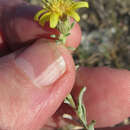Comments
(
anglais
)
fourni par eFloras
Heterotheca canescens grows in southcentral Kansas, eastern New Mexico, western Oklahoma, and much of western Texas, with disjunct populations in the Davis and Glass mountains of trans-Pecos Texas. Disjunct collections putatively from Holt County, Missouri, are of questionable provenance. Heterotheca canescens is silvery gray-green due to the very dense indument of appressed hairs (usually more than 100 per mm 2 ). Tetraploids have more hispid stems and more branched arrays than diploids and can be similar to forms of H. stenophylla var. angustifolia that grow sympatrically in west Texas and Oklahoma. The tetraploids of both taxa apparently hybidize, forming local swarms of parentlike and hybrid individuals.
- licence
- cc-by-nc-sa-3.0
- droit d’auteur
- Missouri Botanical Garden, 4344 Shaw Boulevard, St. Louis, MO, 63110 USA
Description
(
anglais
)
fourni par eFloras
Perennials, 15–40(–65) cm; taprooted, frequently rhizomatous (clonal). Stems 1–75, ascending to erect (proximaly sometimes reddish brown, often whitish due to pubescence, sometimes brittle), often short-branched in distal 1 / 2 , usually sparsely long-hispid (more so in tetraploids), distally strigoso-canescent, eglandular (axillary leaf fascicles often present). Leaves generally ascending, congested; proximal cauline petiolate or subsessile, blades oblanceolate, 19–32 × 2–6 mm, bases convex-cuneate to attenuate, margins flat, entire, strigoso-ciliate, proximally long-hispido-strigose, apices acute, faces densely strigose, long-hispid hairs few, eglandular; distal sessile, usually silvery gray-green, blades linear-oblanceolate, 11–29 × 2–5 mm, little reduced distally, apices acute, faces very to extremely densely strigoso-canescent (90–200 hairs/mm²; silvery-whitish), long-hispid hairs usually few, eglandular. Heads 1–9(–15), borne singly or in corymbiform arrays, branches ascending. Peduncles 2–10 mm, densely strigose, usually sparsely hispid; bracts grading from leaves, proximal oblanceolate, sometimes little reduced distally; long, linear-oblancelate, leaflike bracts often subtending heads. Involucres cylindric to narrowly campanulate, 5–7(–7.5) mm (shorter than disc florets). Phyllaries in 4–6 series, linear-lanceolate to lanceolate, unequal (outer lengths 1 / 5 – 1 / 4 inner), margins scarious, distally ciliate and reddish purple, faces moderately strigose, eglandular. Ray florets 10–22; laminae 5–9(–10.5) × 0.8–1.4 mm. Disc florets (14–)22–40(–50); corollas ± ampliate, 4.7–6.5 mm, throats glabrous, lobes 0.5–0.75 mm, lobes sparsely pilose (hairs 0.1–0.25 mm). Cypselae monomorphic, obconic, compressed, 1.2–3.1 mm, ribs 6–10 (sometimes brownish), faces moderately strigose; pappi off-white, outer of linear scales 0.25–0.5 mm, inner of 25–40 bristles 5–7.5 mm, longest weakly clavate. 2n = 18, 36.
- licence
- cc-by-nc-sa-3.0
- droit d’auteur
- Missouri Botanical Garden, 4344 Shaw Boulevard, St. Louis, MO, 63110 USA
Synonym
(
anglais
)
fourni par eFloras
Haplopappus canescens de Candolle in A. P. de Candolle and A. L. P. P. de Candolle, Prodr. 5: 349. 1836 (as Aplopappus); Chrysopsis berlandieri Greene; C. canescens (de Candolle) Torrey & A. Gray; C. villosa (Pursh) Nuttall ex de Candolle var. canescens (de Candolle) A. Gray
- licence
- cc-by-nc-sa-3.0
- droit d’auteur
- Missouri Botanical Garden, 4344 Shaw Boulevard, St. Louis, MO, 63110 USA
Heterotheca canescens: Brief Summary
(
anglais
)
fourni par wikipedia EN
Heterotheca canescens, common name hoary goldenaster, is a North American species of flowering plant in the family Asteraceae. It has been found in northern Mexico (Nuevo León) and in the Great Plains of the central United States (Colorado, New Mexico, Texas, Oklahoma, and Kansas).
- licence
- cc-by-sa-3.0
- droit d’auteur
- Wikipedia authors and editors
Heterotheca canescens: Brief Summary
(
vietnamien
)
fourni par wikipedia VI
Heterotheca canescens là một loài thực vật có hoa trong họ Cúc. Loài này được (DC.) Shinners mô tả khoa học đầu tiên năm 1951.
- licence
- cc-by-sa-3.0
- droit d’auteur
- Wikipedia tác giả và biên tập viên

